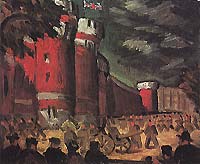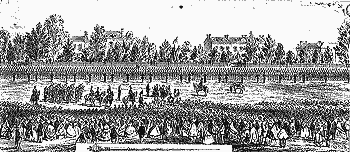|
The see-sawing interests of foreign empires shapes Toronto's destiny. Originally a minor French fort and trading post, it is the British who bring law and governance to the Canadas; cutting out roads that expose the face of Muddy Little York. But the United States looms large across the border. When Yankee forces attack York in the War of 1812, they inflame anti-American sensibilities that will span the history of Toronto. The town cheers as the British retaliate by burning down the White House; then turns again to England for its identity. But most of the Toronto area has been settled by ex-Americans and Loyalists. While the `Family Compact' people assume their English-inspired, aristocratic prerogatives in York, Reformers and rural Loyalists yearn for American-style democracy and the `individual rights' they once knew. The Rebellion of 1837 is fuelled by the longing for democratic government. It fails because of poor planning and leadership, not for lack of conviction. Though British law and order wins over revolution, it is the efforts of Toronto's moderate Reformer, Robert Baldwin, that eventually creates responsible government, and the first modern state in the British Empire.
 |
|
The Armories, Toronto 1939. By Jack Bush |
War and rebellion forge Toronto's civic identity as a city. Toronto regiments become part of national history. While John Simcoe resurrects the Queen's (York) Rangers for road building and defence, the home-grown militia - the York Volunteers - help trounce the Americans at Queenston Heights in the War of 1812. The Queen's Own Rifles, another Toronto regiment, help beat back the Fenian raids at Ridgeway and, under Toronto General Otter, assist in putting down the Riel Rebellion.
Toronto regiments fight in the Boer War as loyal British subjects, and later in the slaughter of World War One. Ten thousand Toronto soldiers are cut down at Ypres, Vimy and the Somme - more than from any other city in Canada.
War propels Toronto toward prosperity. The city flexes its industrial might in the burgeoning aviation industry of the Great War. By WWII the city is Canada's recruiting and training centre as troops exercise at the CNE grounds. Munitions manufacturing boosts Toronto's economy; by 1943, two-thirds of workers are involved in the war effort. Toronto's Massey Harris plant produces wings for the Mosquito fighter bomber and 40 mm anti-aircraft shells that defend London and in the Battle of Britain. At the John Inglis plant on historic Strachan Ave, 17,000 workers, mostly women, turn out 100,000 machine guns.
 |
|
The Presentation of the silver mace to the 2nd Batallion (Queens Own) Volunteer Rifles by the Canada Engraving Establishment, 1863 |
Munitions manufacturing makes Toronto a 24 hour city, as plants work 3 shifts a day. Street car passengers double to 303 million a year during the war. When the troops come home, workers hammer out a new Toronto, clearing downtown slums and erecting Canada's first low-cost housing project - Regent Park.
Next: Immigration: Religious and Ethnic Tolerance
|
